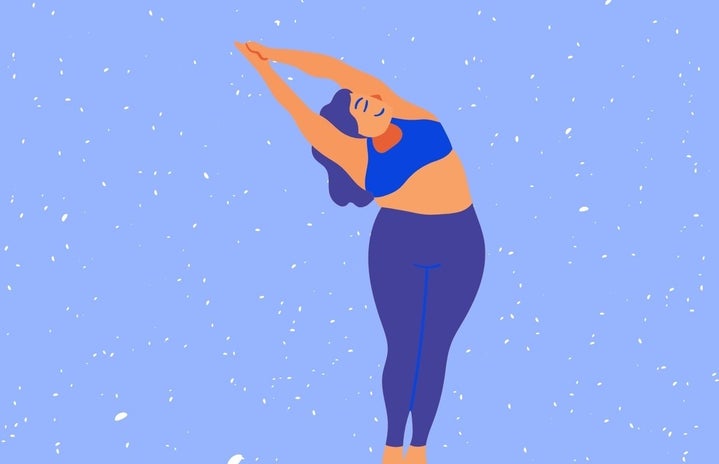As I walk into the yoga studio, I am greeted by gleaming white furnishings juxtaposed with the smell of incense and an intricate display of expensive lotus-flower pants and other gear. There is a smoothie bar in the corner and a sauna down the hall. A short, smiley woman eagerly checks me in and directs me to the hot yoga room. The room is filled with colorful lights and loud music. I lay my mat down in the back of the room and take in my surroundings. Three college students find themselves at home in the front row. A chatty group of middle aged women file in after me. An older man meditates in the corner. The instructor is setting up her station and dons a headset with a microphone. I am already breaking a sweat as the temperature of the room increases to 90 degrees. As I prepare to start class, I cannot help but notice the irony of the situation. It is as if I am living in a stereotype.
My experience in that yoga class is the image that comes to mind when many Americans think of yoga. However, American culture has a long history with the practice of yoga. First seen as a foreign circus act to ooh and ahh over, yoga in the US quickly became a symbol of the cultural “other.” A purity panic in the US—combined with a surge of East Asain and Indian immigration—left yoga as a massive unknown to America. It was a perfect storm of events that led to a public opinion of yoga as “anti-american”; something to protect young women and wives from. A famous swami, Yoganumla, was run out of Miami by 200 angry husbands who believed their wives had become part of some sort of love cult. Eleanor Roosevelt was once caught doing headstands in her room at the White House, causing a public controversy. Roosevelt claimed she “‘Did not know they were called yoga exercises.’” (Love, 5)
This fear of yoga provided the narrative for the next few decades, and it wasn’t until beloved celebrities such as Marilyn Monroe and Cole Porter spoke in favor of yoga that it was ever taken seriously by the American audience. The sweeping voice of celebrity has a profound impact on the public to this day. In a mere few decades, yoga was transformed from an anti-American cult activity to the latest fitness craze.
This brings about the narrative of yoga that comes to mind to many Americans nowadays: the lavender colored walls and lotus-patterned pants (Rosin, 116). This is the narrative that is upheld in my own experience of yoga class. This is the narrative that has become a stereotype in our modern world. I am paying nearly $50/month to sit in this 90° room. Has yoga been transformed into a mere symbol of wealth and exclusion? The yoga studio begins to fill up as I take a second look at my surroundings, this time with a more critical eye. The room is filled with predominantly thin, white women, expensive athleisure brands abound.
The lack of diversity in my yoga class begged the question: What are western yoga studios doing to make yoga practice more accessible to marginalized groups? Sangha Studio is a non-profit, donation-based yoga studio with multiple locations in the greater Burlington area. Their website states: “We acknowledge that yoga in the West has historically been inaccessible to those with financial and physical barriers. We work to host studio classes that are accessible to anyone that may want to join us for practice to the best of our ability” (Sangha). Sangha aims to uphold their values of inclusivity, connection, and access by offering donation-based classes, a sliding scale membership, scholarships, and adaptive classes.
Yoga has certainly been normalized in our society, but does it make yoga more accessible, or does it create an exclusive environment that drives people away from the practice? Recent studies take a social justice lens to the accessibility to yoga for marginalized groups. BIPOC, LGBTQ+ folks, lower income, larger-bodied people, those with disabilities, the elderly, and men are identified as groups that were driven away from yoga because they feel that they would not fit in (Webb, 364). The study identifies physical, emotional, and psychological benefits of yoga for these groups. In particular, yoga is found to reduce or diminish symptoms of disordered eating and improve mental health.
Queen City Yoga, another local studio, puts an emphasis on community and health. They offer hot yoga, HIIT, and pilates classes. Their website features a blog with posts on how to nourish properly for their classes, the benefits of their hotroom, and an otherwise behind-the-scenes look at their operation. Their instructors tell inspiring stories and boast rigorous credentials (Queen). Queen City Yoga’s emphasis on community healing transforms it from a trendy studio to a safe space for all participants.
Sangha Studio and Queen City Yoga are doing the work to make the yoga space a more accessible and inclusive environment. As someone who practices yoga, I hope to see more yoga studios follow in the footsteps of these leaders in the coming years. The mental and physical health benefits of yoga are vast, and its normalization in our culture should be a good thing. It is essential that western yoga studios acknowledge the complicated history of yoga and honor the origins of the practice. Yoga is a gift, and we should treat it like one.
References
Love, R. (2006, November). Fear of Yoga. Columbia Journalism Review, 80–90.
Queen City Yoga & Fitness. (n.d.). Retrieved from https://www.queencityogavt.com/
Rosin, H. (2006). Striking a pose. The Atlantic Monthly, 289(5), 114–119. doi:10727825
Sangha Studio. (n.d.). Retrieved from https://www.sanghastudio.org/
Webb, J.B., Rogers, C.B., & Thomas, E.V. (2020) Realizing yoga’s all-access pass: a social justice critique of westernized yoga and inclusive embodiment. Eating disorders. 28(4), 349-375, doi:10.1080/10640266.2020.1712636
**Edited by Beth Dawkins on 4/27/22


